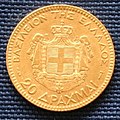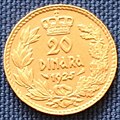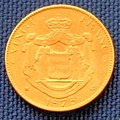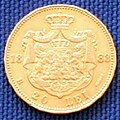Latin Monetary Union
The Latin Monetary Union (officially Union monétaire latine ) was a currency union between France , Belgium , Italy and Switzerland , which existed from December 23, 1865 in fact until 1914 and formally until December 31, 1926.
Spain , Greece , Romania , Austria-Hungary , Bulgaria , Serbia , Montenegro (all monarchies) and Venezuela also joined the Union's regulations. A bimetallic silver-gold standard thus prevailed in much of Europe . It is considered to be the only outward result of Panlatinism .
Some other countries influenced their coins under the provisions of the Monetary Union, but were not with her.
History and main features of the coin union
In 1795, France introduced the franc at 100 centimes as the second decimal currency after the US dollar . The weight of the silver coins was standardized so that one franc weighed exactly 5 grams of 900/1000 silver, i.e. 4.5 grams of fine silver . Gold coins were also minted within the same currency system , with the value ratio of silver and gold being set at 1: 15.5. This system was brought to Italy with Napoleon's Italian campaign (1796/97). The Helvetic Republic existed in Switzerland from 1798 to 1803 ; here France introduced a single currency ( Swiss francs ). In 1803 mint sovereignty returned to the cantons; After Switzerland became a federal state in 1848 , the federal government was responsible for the currency. The Swiss franc was introduced as a currency with the “Federal Law on Federal Coinage” of May 7, 1850; it was based on the French (silver) franc.
Before the official start of monetary union, similar conditions existed in several countries, with coins and banknotes from other countries being partially accepted as a means of payment. Belgium, which emerged as a state after the Belgian Revolution (1830), introduced the Belgian franc in 1832 . The model was the French franc ; its course was linked to this in a ratio of 1: 1. The bimetallism between gold and silver coins stipulated in the Latin Monetary Union was expressed as follows: Two silver 5-franc pieces (= 45 grams of fine silver) corresponded to one golden 10-franc piece (= 2.9032 grams of fine gold), i.e. 15, 5: 1 in the mass ratio of the fineness. In addition to gold coins , only the silver 5-franc piece was intended as a Kurant coin .
Félix Esquirou de Parieu (1815-1893) was the pioneer of the coin system initiated by France in 1865 . He understood the coin system - beyond the financial advantages - as a preliminary stage to a “European Union” with a “European Commission” as political leadership. Napoleon III saw the Monetary Union as a means of "hegemony over continental Europe".
In 1865 France , Belgium , Italy and Switzerland signed a treaty which (since its entry into force on August 1, 1866), in addition to the technical details of these coins, uniformly regulated the issuing policy and mutual recognition. Greece joined the Union on December 21, 1868 . Fluctuations in the silver and gold prices led to the problems inherent in bimetalism, also for the Coin Union, as the forces of the market partially opposed the provisions of the treaty. According to Gresham's law , a compulsory exchange rate between two types of money - here the legally established exchange rate between gold and silver coins - means that the more valuable good types are hoarded or melted down. The poorer , less valuable coins, on the other hand, are used for payment. On the part of the state there is an incentive to increasingly mint the coins that are cheaper to produce and to keep the good types. This led to a temporary shortage of certain and excessive circulation of other coins. The biggest problem, however, was that countries like Italy or Greece printed a large number of paper money denominated in a currency belonging to the Coin Union. The issue of paper money was not expressly excluded in the contracts. Excessive issuance of currency tokens led to inflation (see monetarism ).
The contract, which was originally supposed to expire at the end of 1879, was renewed on November 5, 1878, initially until December 31, 1885, with the decision to discontinue the production of silver 5-franc pieces due to the significantly lower silver price .
In Germany, 1871 silver coins ( dollars ) predominant, the value of which in principle by its silver content covered was ( Silver Standard ; Kurantgeld ). After 1871 - following the English model - the silver standard was replaced by the gold standard . As a result, silver largely lost its monetary importance. The value ratio fell from 1:14 to 1: 100 for a while, later it rose again a little. From 1873 the price of silver fell due to the large German silver sales. Silver inflation in the 1880s prompted the Latin Monetary Union to introduce the gold standard in 1885. On November 6, 1885, a new treaty with partially changed provisions came into being, which remained in force until January 1, 1891 and was then tacitly extended for a further year, provided that a member state did not terminate the contract.
There was no regulation on paper money. Italy and Greece used this loophole to increase the circulation of paper money, which led to inflation. The Italian and Greek silver divide coins therefore flowed from these countries to other countries of the Latin Coin Union and were missing in the coin system of Italy and Greece. Italy therefore applied for nationalization of its silver dividing coins in 1893 and Greece in 1908 (in the Greek case only one and two drachmas, not the rest). The coins were confiscated in the other countries of the Latin Monetary Union and were no longer legal tender there. They were sent back to the countries of origin; the recruiting countries received compensation from Italy and Greece. In Greece, these coins were used to replace paper notes with a face value of one and two drachmas. However, this did not mean the exclusion of Greece from the Latin Monetary Union, as was repeatedly claimed in some media in 2015 in connection with the possibility of a current Grexit . Rather, Greece remained a member of the Latin Monetary Union until its dissolution in 1927. An article by Herbert Hutar in the Wiener Zeitung comes to this conclusion.
On November 4, 1908, the Belgian Congo officially became a member of the Union of Coins.
The First World War led to an enormous need for money. The contracting states (with the exception of Switzerland) were forced to turn away from a currency based on precious metal Kurant coins . Parts of the contract were gradually canceled. The Scandinavian Monetary Union was also abolished as a result of the First World War. After the de facto dissolution of the Latin Monetary Union, Belgium terminated its membership in 1926. On January 1, 1927, Switzerland was the last country to put the coins of the other countries out of circulation.
Coinage
Each member state minted its own coins with its own currency denominations. The currency units, which had a ratio of 1: 1 to each other, were the franc to 100 centimes in France and Belgium, the franc to 100 centimes in Switzerland, the lira to 100 centesimi in Italy and the drachma to 100 lepta in Greece.
The following coins were permitted under the terms of the treaty:
Face value Weight diameter metal 100 Fr. 32.26 g 35 mm Gold 900/1000 fine 50 Fr. 16.13 g 28 mm Gold 900/1000 fine 20 Fr. 6.45 g 21 mm Gold 900/1000 fine 10 Fr. 3.23 g 19 mm Gold 900/1000 fine 5 Fr. 1.61 g 17 mm Gold 900/1000 fine 5 Fr. 25.00 g 37 mm Silver 900/1000 fine 2 Fr. 10.00 g 27 mm Silver 835/1000 fine 1 Fr. 5.00 g 23 mm Silver 835/1000 fine 0.50 Fr. 2.50 g 18 mm Silver 835/1000 fine 0.20 Fr. 1.00 g 16 mm Silver 835/1000 fine
Before the introduction of the treaty norms, gold coins at 40 francs and 80 francs (lire) and silver coins at 0.25 francs were minted according to this system. These were withdrawn soon after the contract was signed, as were older coins that corresponded to the weights of the contract, but not in terms of fineness or diameter. Not all approved coins were minted by all member countries.
The coins from 2 francs down were of a lower fineness , which meant that their face value was not completely covered by their metal value, which made them deciduous coins . Dividing coins made of base metal were not part of the contract and were issued according to different standards depending on the member state.
The public coffers of the member countries were obliged to accept the gold coins and the 5-franc pieces (corresponding to lire , Swiss francs and drachmas). It was limited to 100 francs for smaller silver denominations . The circulation of its own paper money and foreign currencies was the responsibility of each member state.
Takeover of the system of the Coin Union without joining the contract
The following states and territories minted coins according to the same system, but with their own national currency denomination, without officially joining the Coin Union:
- Finland 1860-1918
- Papal States 1866–1870
- Romania 1867–1944
- Spain 1869-1934
- Serbia 1873–1915
- Venezuela 1879-1965
- Bulgaria 1880-1916
- Argentina 1881-1893
- Tunisia 1891–1928
- Danish West Indies 1904–1905
- Poland 1924-1925
- Albania 1925–1938
Character as a means of payment in the contracting states
The coins minted by the non-members according to the system of the Mint Union were not legal tender in the contracting states ; some of them (the gold and large silver coins) nevertheless circulated internationally.
Austria-Hungary and Russia were also indirectly members of this currency union via their almost straight exchange rate: 4 guilders (from 1892: 8 kroner ) = 10 francs and 1 (gold) ruble = 4 francs. As early as 1870 Austria-Hungary minted gold coins of 4 and 8 guilders as trading coins , which had the additional denomination of 10 Fr and 20 Fr respectively .
The Russian-Finnish gold coins of 10 and 20 Markka also corresponded in fineness to the 10 and 20 francs, while the silver coins were not minted according to the regulations of the Latin Monetary Union.
Illustrations of coins
- Coins of the contracting countries
- Coins from some non-contracting countries
Economic conclusions
The Austrian economist Theresia Theurl assessed interstate currency unions as fundamentally unstable, as the sovereignty of the individual states calls into question compliance with the rules. “All monetary unions that were not full political unions remained temporary arrangements. They dissolved. "
Due to the history of the Latin currency union, the German historian Dominik Geppert rules out that power-political rivalries could be ended by a currency union. Such an order also absolutely needs a regulation on resignation. The intergovernmental agreements are also fragile and not necessarily credible.
A plausible reason for the dissolution of the Latin Monetary Union was the considerable difference in the economic development of the member countries.
literature
- Ludwig Bamberger : The fate of the Latin coin federation. A contribution to monetary policy . Simion, Berlin 1885 (digitized edition under: urn : nbn: de: s2w-4268 ).
- Albert Niederer: The Latin Monetary Union. Catalog of all coins of the 5 Union states with legal validity in Switzerland from 1852–1927 = L'Union Monétaire Latine . Helvetic coin newspaper, Hilterfingen 1976.
- Silvana Koch-Mehrin : Historical monetary union between economy and politics. The Latin Monetary Union 1865–1927. Nomos-Verlag, Baden-Baden 2001, ISBN 3-7890-7631-7 (revised version of their dissertation , Heidelberg 2000).
- René Frank : An overview of the different coins according to the norms of the Latin Monetary Union . In: moneytrend 6/2005, ZDB -ID 630026-1 , pp. 180-185 ( online ; PDF; 2.0 MB).
- Theresia Theurl : A common currency for Europe. 12 lessons from history (= history & economics, 1). Österreichischer Studien-Verlag, Innsbruck 1992, ISBN 3-901160-05-1 , pp. 175-213.
- Guido Thiemeyer : Internationalism and Diplomacy. Monetary policy cooperation in the European State System from 1865 to 1900 (= Studies on International History , Volume 19). Oldenbourg, Munich 2009, ISBN 978-3-486-58431-8 (habilitation thesis Uni Kassel 2004).
- Guido Thiemeyer: Otto von Bismarck, Napoleon III. and the Latin Monetary Union. In: Bank historical archive. Vol. 28/1 (2002), pp. 1-20.
- Henry Parker Willis: A History of the Latin Monetary Union . A Study of International Monetary Action . University of Chicago Press, Chicago IL 1901.
- Robert Greul: The Latin Monetary Union. A study under international law. Berlin 1926.
- Catherine Brégianni: Monetary mechanisms and numismatic representations in the era of the first globalization: the Greek paradigm of the 19th century. In: G. Depeyrot , M. Kovalchuk, C. Brégianni (Ed.): Three Conferences on International Monetary History. Wetteren 2013, pp. 19–42 ( https://www.academia.edu/3822052/Monetary_mechanisms_and_numismatic_representations_in_the_era_of_thefirst_globalisation_the_Greek_paradigm_of_the_19_th_century ).
- Κατερίνα Μπρέγιαννη [Katerina Bregianni]: Νεοελληνικό νόμισμα: Κράτος και ιδεολογία από την επανεάστασην επανεάστομο έως πομεο currency [ πλμομο έως [ πλμεομομομο Currency State and Ideology From the Revolution Until the Interwar Period]. Athens 2011.
- John Chown: A History of Monetary Unions. Routledge, London / New York 2003.
- Herbert Hutar: Dangerous Speculation. In: Wiener Zeitung, 18./19. July 2015, p. 36.
Web links
- The Latin Monetary Union: 1865–1926
- List of all LMU gold coins
- Chronicle of the Latin Monetary Union
- Sandro Guzzi-Heeb: Latin Coin Union. In: Historical Lexicon of Switzerland .
Individual evidence
- ↑ see Kingdom of Spain , Kingdom of Belgium , Kingdom of Romania , Tsarist Bulgaria , Kingdom of Serbia and Kingdom of Montenegro . France was the Second Empire until 1870 and a republic from 1871 .
- ^ Hermann Wagner (1840–1929): Biological Geography. Salzwasser Verlag, 2012, p. 828 (reprint of the 10th edition of the work from 1923; online version here ).
- ^ A b c d Philip Plickert : How Greece regrettably flew out of monetary union: regrettably bankrupt . FAZ.NET , February 18, 2015.
- ^ Robert Greul: The Latin Coin Union. A study of the history of international law. Berlin 1926, pp. 118-126.
- ↑ Herbert Hutar: Dangerous Speculation. In: Wiener Zeitung, 18./19. July 2015, p. 36.
- ^ Monetary history of the Congo . National Bank of Rwanda, accessed August 30, 2012
- ↑ Heinz Fengler, Gerd Gierow, Willy Unger: transpress Lexikon Numismatics. Berlin 1976 (see under “Latin Coin Union”).









